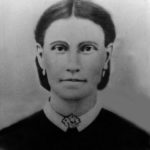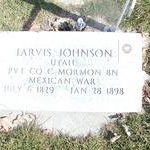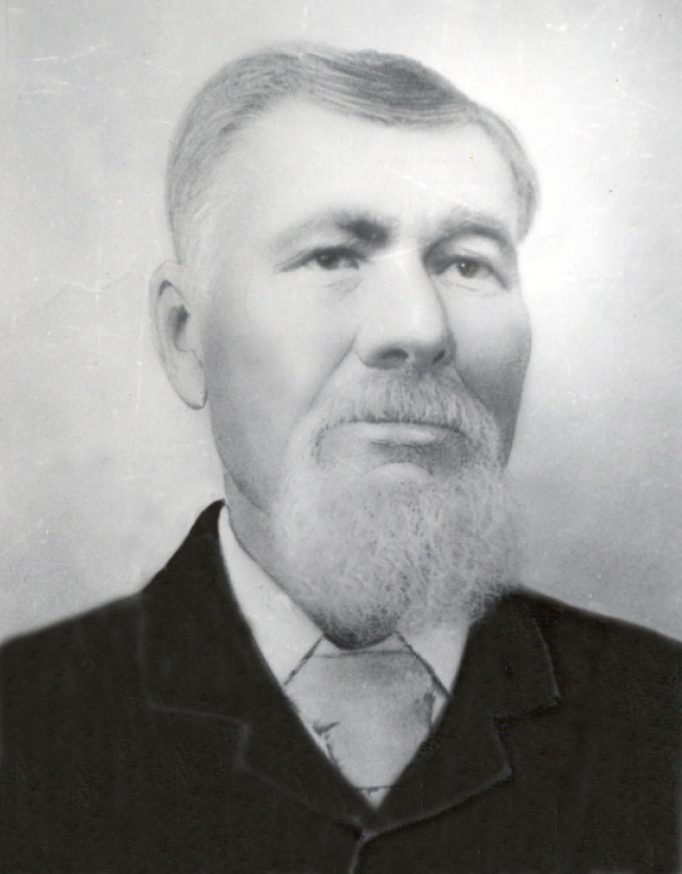(Contributed by the Thomas Tolman Family Organization. The following excerpt is taken from Benjamin Hewitt Tolman: Brother, Pioneer, Husband, Father by Dawnine T Mills Johnson, First Edition, 2014, pages 6-1 to 6-8).
[Author’s Note: All of the histories of Jarvis Johnson used in this narrative were taken from the undated booklet “Race Alphalus Johnson & Charlotte Maria Whitworth & families”, inpossession of the author. There seems to be a problem with some of the dates and ages in the narrative.]
Jarvis Johnson was born July 6, 1829, in Lincoln, Addition County, Vermont, to Peter Johnson and Lucina Roberts, who had married November 24, 1824, in Lincoln, Addition County, Vermont . Lucina’s parents were Elisha Roberts (who was born in Lincoln, Addition County, Vermont, and died in 1852 in Bristol, Addition County, Vermont) and Polly or Mary Durfee (who was born 5 May 1787). They were married in 1805.
Per “Excerpt from Conquerors of the West: Stalwart Mormon Pioneers”, Volume 2, Jarvis was about 9 years old when he traveled from Vermont to Ohio with his family. His father and two siblings died of cholera and all their possessions were burned and the bodies buried in the Ohio River. The remaining members of the family traveled to Illinois. Lucina, his mother, Jarvis age 15, and his 11 year old brother joined the Church of Jesus Christ of Latter Day Saints. Apparently after they arrived in Nauvoo, Lucina became a polygamist wife of Reynolds Cahoon, who was 17 years older than her. Reynolds Cahoon and his entire family left Nauvoo with the Saints.
Trek West and the Mormon Battalion
(Author’s Note: If Mormon Battalion was called together on July 18, 1946, Jarvis would have just turned 17 when he joined since his birth date was July 6, 1829. The following are several versions of Jarvis joining and serving with the Morman Battalion.)
In early 1848 the bitter wind of the prairieland found Lucina Roberts Johnson Cahoon with her infant son, Rais, 13-year-old Leman and 17-year-old Jarvis on the plains of Iowa. In the same encampment were Francello Durfey and the Truman O. Angells nearby. When the U.S. officers came to enlist Mormon men to help with the war against Mexico, with Brigham Young’s approval, Francello stepped forth to enlist. Jarvis, who idolized Francello could not bear to be left behind. He said he was 18, the required age, and stood on tiptoe to measure up to the required height. To his great joy and doubtless to the sorrow of Lucina he was mustered in the U.S. Army. He was a member of the famed Mormon Battalion.
Jarvis doubtless enjoyed the big farewell send-off the Saints gave the enlisted men of the Battalion. He listened with the others to President Young as he instructed them to be true to their God and their country, to be virtuous and clean, refrain from profanity and obscenity and to pray always. And then the promise if they did they would not be engaged in any battle and have no bloodshed.
Taken from “Jarvis Johnson 1829 — 1898” by Jennie B. Hollist, In July of 1846 at the age of 16 while encamped on the Iowa prairies, he joined the U. S. Army under Captain James Allen to serve as a soldier to fight the recently declared war against Mexico. The group left Council Bluffs with 541 soldiers (497 were Mormons). They were organized into five companies, fifteen to twenty officers and their families and twenty soldiers with families to serve as laundresses.
The Battalion marched southwest to the Arkansas River coping with lice, mosquitoes and cattle-stealing Indians along the way. Captain Allen died and the Battalion was soon under Lt. Andrew Jackson Smith who disliked the Mormons. By September it was clear the march was not for women and children, so Lt. Smith ordered most of the soldiers with families and the sick to go to Pueblo, Colorado for the winter. The main body continued on to Santa Fe arriving in October of 1846. Here Lt. Col. Cooke took charge of the Battalion and 86 sick soldiers were sent to Pueblo along with the remaining women. Five officer’s wives were allowed to continue.
Jarvis was with the group who stayed at Pueblo for the winter, then in the spring of 1847 left to meet Brigham Young’s company on their way west to the Valley. They arrived in the valley a few days after Brigham Young in July 1847. Jarvis stayed and helped the Saints dig ditches for crops and build the bowery to use for meetings and school.
It is not clear just when Jarvis left Salt Lake and returned to Iowa, but two years later on August 5, 1849 he married 15-year-old Hester Ann Jackson who was born 25 May 1834 in Knox County, Ohio, a daughter of William and Charlotte Caroline (Noble) Jackson.
After being in Illinois and Missouri for ten years, they sold their land grant property and started to join the Saints in the Utah territory. When they reached Nebraska with their five children, his wife Hester Ann died (May 11, 1859), leaving a four-month old baby. The oldest child Mary Charlotte was eight and a half years old.
It was an incredibly difficult march but even into his last years, Jarvis remembered it as the highlight of his life. He remembered the astonishment of the officers at Fort Leavenworth where they were outfitted that every Mormon recruit could sign his own name.
Information about the Mormon Battalion: United States President James K. Polk called for 500 to 1,000 Mormon volunteers to march to Fort Leavenworth (present-day Kansas) and then to California on a one-year U.S. Army enlistment. The U.S. was involved in the Mexican-American War. Mormon recruits were called together Saturday, July 18, 1846. Monday, July 20, 1846, the Mormon Battalion marched off. Their trek was 2,000 miles from Council Bluffs, Iowa, to San Diego, California. Battalion members honored their military assignment, some for one to three years and others for nearly a decade. President Brigham Young prophesied that not a single battalion member would be lost to hostile action. Twenty members died due to the privations they suffered. Not a single shot was fired by the Mormon Battalion except at a herd of rampaging bulls. The battalion arrived in San Diego 29 January 1847, making the journey the longest religious march in U.S. history. The Mormon Battalion carved out a vital road for wagons through the American Southwest. The battalion was the only religious military unit in
American history. (Taken from a Mormon Battalion Fact Sheet issued by the Church of Jesus Christ of Latter-Day Saints.)
Taken from “Jarvis Johnson” by Lucile Bateman Johnson:
Jarvis would have been 16 when he started with the Brigham Young Company, which is where he joined the Mormon Battalion. Jarvis said he had to stand on tip toes to be tall enough. He endured the hardships, which were many for this noble band of men. This battalion was composed of some 500 hand-picked men, who were taken from the ranks of the Mormons, by the order of Brigham Young, just as the pioneers were preparing to cross the trackless plains to Utah. These raw recruits were sent down to help our country fight Mexico. The war ended before they reached the scene of action, but they experienced a troublesome and perilous journey of many hundreds of miles on foot.
After his release from the Mormon Battalion, Jarvis started back in Captain Brown’s Company, arriving in Salt Lake City, five days later than the first band of pioneers. He helped build the first bowery there. After resting in the valley for a few months, he and a few others started back to Winter Quarters, Nebraska, with 6 lbs of flour for each man. In 1849, he assisted in bringing a company across the plains and returned the same year to Nebraska. In 1850, he met and married Hester Ann Jackson. She died in 1860, leaving him with five little children. He brought them back to Utah.
From Nebraska he returned to Missouri to get his sweetheart, Hester Ann Jackson, and they were married. In 1859 they sold their land and started to the Valley, but Hester died en route. (Excerpt from “Conquerors of the West: Stalwart Mormon Pioneers”, Volume 2).
Then taken from “Our Gallery of Pioneers – Jarvis Johnson” by Alma J. Knapp, son-in-law of Jarvis Johnson and husband of Hazel J. Knapp, submitted to Ruby J. Thornley – Family Gen. Rep, Ogden, Utah, October 24, 1960:
Jarvis Johnson was only seventeen when he enlisted in the Battalion at Council Bluffs in 1848, and he was one of those who spent the following winter in Pueblo. He assisted in the erection of the original Bowery on the site of the Temple Block in this city, the first place for public assemblages in the country, and when the time came, in mid-August, for the return of some of the pioneer and battalion men to go to the Missouri River to rejoin their families and to assist in forwarding the remaining companies from the frontier, he went along as a member of the fourth “ten” of the second Division [sic]. When he again came to Utah to make here a permanent home, he located in Box Elder County, with residences in Brigham City and Beaver Dam. He was a machinist by trade, and was a useful and respected member of the community.
Jarvis Marries Hester Ann Jackson
Jarvis’ first wife was Hester Ann Jackson. She was born May 25, 1834 to William Jackson and Charlotte Caroline Noble, in Knox County Ohio. They had five children: Mary Charlotte, born December 14, 1850 in Savannah, Andrews County, Missouri, (she married Rais Cahoon); Melissa Carolina, born February 19, 1853, Savannah, Andrews County Missouri, (she married Alexander Becksted Hunsaker); Lucina Johnson, born April 5, 1855, Savannah, Andrews County, Missouri, (she married Denmark Jensen); William Leamon, born January 27, 1857, in Otoe County, Nebraska, (he married Katie Wickham); and finally John Henry, born January 29, 1859, in Jackson, Missouri, (he married Sophena Hansen).
Hester died May 11, 1859, and was buried on May 14, 1859, in Otoe County, Nebraska. When she died, her baby, John Henry, would have only been about 3-1/2 months old. Mary would have been 8-1/2, Melissa would have been 6, Lucina only 4 and William Leamon, 2 and nearly 3 months. This must have been a very hard time in Jarvis Johnson’s life.
Jarvis Marries Sarah Jane Angell Tolman
[Author Note: While checking the 1850 census for information about Jarvis’ mother, Lucina Roberts Johnson Cahoon, Reynolds Cahoon and family and Lucina and several young children are listed on the census sheet immediately before the names of Truman O. Angell and his wife, daughters. This could mean that Lucina and the Angell family knew each other and were quite possibly neighbors. Speculation is whether Jarvis knew the Angell family and was later made aware of the fact that Sarah Jane was a widow.]
 Jarvis met and married Sarah Jane Angell Tolman on September 16, 1860, with Sarah Jane already having three children she had had with Benjamin Hewitt Tolman. Jarvis and Sarah Jane had seven children: Martha Ann, born August 19, 1862; Jarvis Truman, born December 1, 1863 (who died one day before Rais Johnson’s birth, on October 3, 1865); Rais [sic] Alphalus, born October 4, 1865; Alice Alvaretta, and Alonzo Alvaro, twins born the December 17, 1866; and Sarah Jane and Peter, twins born March 21, 1869. This second set of twins died in their youth. Sarah died March 23, 1880, and Peter died June 22, 1871.
Jarvis met and married Sarah Jane Angell Tolman on September 16, 1860, with Sarah Jane already having three children she had had with Benjamin Hewitt Tolman. Jarvis and Sarah Jane had seven children: Martha Ann, born August 19, 1862; Jarvis Truman, born December 1, 1863 (who died one day before Rais Johnson’s birth, on October 3, 1865); Rais [sic] Alphalus, born October 4, 1865; Alice Alvaretta, and Alonzo Alvaro, twins born the December 17, 1866; and Sarah Jane and Peter, twins born March 21, 1869. This second set of twins died in their youth. Sarah died March 23, 1880, and Peter died June 22, 1871.
The birth of these twins caused the death of their dear mother—the same day they were born, by hemorrhage, just 9 years after their marriage. Sarah Jane died March 21, 1869, leaving Jarvis with six additional children under the age of 7 years old.
Jarvis Marries Mary Jane Ainsworth
Jarvis then on January 17, 1870, married his third wife, Mary Jane Ainsworth, who was 16 years old.
Taken from “Notes added Marilyn C. Johnson”, his third wife, Mary Jane Ainsworth Johnson, was a good stepmother, and prayed daily that she would be. Her prayers were answered for her stepchildren loved her.
Per U.S. Census for 1870, for Beaver Dam, Box Elder County, Utah, listed before Jarvis and Mary Johnson on the census form is the family of Leman Johnson who was born in New Hampshire. In Jarvis’ obituary it lists that “he died 24 hours after his brother, Leman died”.
In 1880, Jarvis and his family moved to Beaver Dam, Box Elder County. Mary Jane and Jarvis had 10 children together: Mary Emereta, Sarah Adelaide, Jarvis, Joseph Seymour, Cynthia, Haze, Myrtle, Oren Ainsworth, Wallace and Ruby Ainsworth.
 Jarvis Death
Jarvis Death
When Jarvis died Mary Jane was left a widow when her last baby was only 1-3/4 year old. He had 2 married children and eight of the children still at home.
Jarvis died Friday, January 28, 1898, at his home in Beaver Dam, Box Elder County, of Bright’s Disease, after having suffered severely since January 1st. Per the Editorial in the Bugler,
Jarvis Johnson, age 70, was buried in Brigham City, Monday, 1st of February 1889, in the afternoon. The corpse was brought down in a sleigh, it requiring from 7 a.m. to 1 p.m. to travel the 25 miles. Many friends and relatives accompanied the remains on the long, sad trip. The sorrowing family have [sic] the sympathy of the entire community in the loss of their highly respected member.
The deceased was a very active worker in building up the Kingdom of God. He was a kind, loving husband, and highly respected by all who knew him. He leaves a wife, 19 sons and daughters (with an additional 3 children who died in their youth), 78 grandchildren and 19 great-grandchildren. The funeral services were held in Beaver Dam Sunday, and the remains were taken to Brigham City, where services were held
Monday.
From “JARVIS JOHNSON” Written by Esta Webb Brown, Granddaughter:
Jarvis was buried at Brigham City. Mary Jane was left with a young family. Before he [Jarvis] left her, he gave her a blessing promising her that she would never want for the necessities of life and that she would be able to do the job of raising their family without him, and do it so well that he would be proud to call her his in the life to come. This blessing came true in every way. She never wanted for the necessities of life and her family was one of love, kindness and tenderness.
Visit FamilySearch to learn more about Jarvis Johnson and other ancestors. Also visit the Thomas Tolman Family Organization to find out how you can get more involved in family history.


